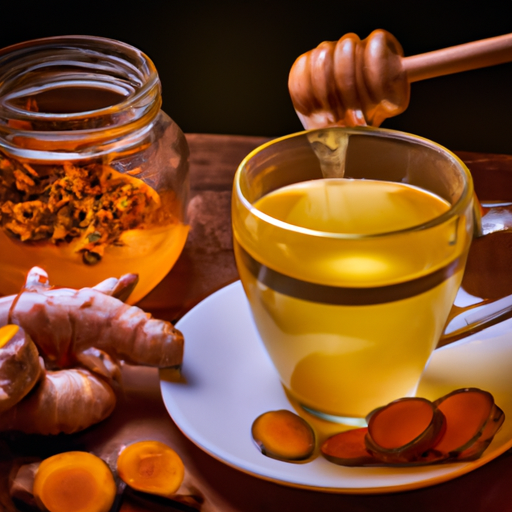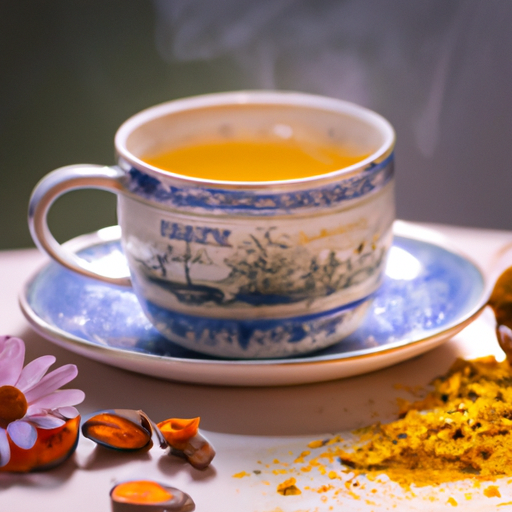You’ve probably been informed about the health advantages of turmeric. However, let’s face it, the flavor can be a bit strong for some. But fear not, with a few easy tricks, you can make turmeric tea taste delightful and pleasant.
Turmeric tea is a popular drink that has been used for centuries in traditional medicine practices. It is known for its anti-inflammatory properties, and can help with digestion and boost the immune system. While the health benefits are undeniable, the taste of turmeric can be described as earthy, bitter, and pungent.
But don’t let that discourage you! With some experimentation and creativity, you can make a cup of turmeric tea that is not only good for you, but also tastes great.
Key Takeaways
- Use organic turmeric for richer flavor and sustainability
- Experiment with different flavor combinations, such as adding citrus fruits, cinnamon, or ginger
- Sweeten with honey, stevia, agave, or maple syrup to balance the earthy and bitter taste
- Add a pinch of black pepper to enhance the absorption of curcumin, but avoid heating turmeric too long or at high temperatures to prevent loss of potency.
Understanding the Flavor Profile of Turmeric Tea
You may think that turmeric tea has an overpowering taste, but once you understand its flavor profile, you’ll be able to appreciate its unique and complex taste. Turmeric tea flavor is earthy, slightly bitter, and slightly spicy. Some people may find the taste too strong, while others may enjoy it.
Taste preferences may vary, and it’s essential to understand your taste buds to make turmeric tea taste good for you. To make turmeric tea taste good, you can adjust the flavor profile by adding ingredients that complement its taste. For example, you can add honey, ginger, or lemon to enhance the tea’s sweetness, spice, and tanginess. The key is to experiment with different ingredients and find the right balance that suits your taste buds.
With a little bit of creativity and patience, you can make turmeric tea taste good and enjoy its health benefits. Now, let’s move on to choosing the right turmeric for your tea.
Choosing the Right Turmeric for Your Tea
When choosing the right turmeric for your tea, consider whether you want to use fresh or dried turmeric. Fresh turmeric has a more vibrant flavor but can be harder to find, while dried turmeric is easier to come by and has a longer shelf life.
Additionally, you may want to consider using organic turmeric to avoid any potential exposure to pesticides or other harmful chemicals commonly used in non-organic farming practices.
Fresh or Dried Turmeric
Using fresh or dried turmeric in your tea can add a warm and earthy flavor that complements the other ingredients. If you choose to use fresh turmeric root, simply peel the outer layer and grate it into your tea. Dried turmeric, on the other hand, is easier to find in grocery stores and can be used by adding a teaspoon or two to boiling water.
Aside from its flavor, turmeric also boasts a number of health benefits. It contains curcumin, a compound known for its anti-inflammatory and antioxidant properties. Drinking turmeric tea regularly can help reduce inflammation in the body and may even improve brain function.
Now that you know about the benefits of using turmeric root, let’s move on to the next step: deciding whether to use organic or non-organic turmeric.
Organic vs. Non-Organic Turmeric
Opting for organic turmeric may provide a peace of mind knowing that the root was grown without the use of synthetic pesticides or fertilizers. Organic sourcing refers to the cultivation of turmeric that meets the strict standards set by regulatory bodies such as the USDA. These standards ensure that the turmeric is grown using sustainable and eco-friendly methods, which not only protect the environment but also promote better health for the consumers.
Here are some things to consider when deciding between organic and non-organic turmeric:
- Organic turmeric may have a richer flavor profile due to the natural cultivation practices.
- Non-organic turmeric may have a higher risk of contamination from synthetic fertilizers and pesticides.
- Organic turmeric is more expensive than non-organic turmeric due to the higher costs associated with organic farming.
- Non-organic turmeric may come from sources with questionable labor practices.
- Choosing organic turmeric may support the livelihood of small-scale farmers who practice sustainable agriculture.
When it comes to making turmeric tea taste good, the quality of the turmeric you use can make all the difference. Now that you know the benefits of organic sourcing and turmeric cultivation practices, let’s move on to the next step of experimenting with different sweeteners.
Experimenting with Different Sweeteners
Try experimenting with different sweeteners to find the perfect one for your taste buds when making turmeric tea. While honey and stevia are popular choices, agave and maple syrup are also great alternatives. Keep in mind that each sweetener has its own distinct flavor, and it’s important to find the one that complements turmeric the best.
Honey has a floral taste that pairs well with the earthy flavor of turmeric, but it can be overpowering if too much is added. Stevia, on the other hand, is a natural sweetener that has a subtle taste and is calorie-free. Agave and maple syrup both have a lower glycemic index than honey, making them a healthier option. Agave has a mild, sweet taste, while maple syrup has a rich, caramel flavor that can add depth to your turmeric tea.
Experiment with different amounts and combinations of sweeteners until you find the perfect balance for your taste buds.
Adding citrus fruits to your turmeric tea can also enhance its flavor profile. By adding a slice of lemon or lime, you can give your tea a tartness that balances out the sweetness. Plus, citrus fruits are packed with Vitamin C, which can boost your immune system and help your body absorb the benefits of turmeric.
Try squeezing in a wedge of lemon or lime to your sweetened turmeric tea for a delicious and healthy beverage.
Adding Citrus Fruits
If you’re looking to make your turmeric tea taste better, you might want to consider adding citrus fruits. Not only do they add a refreshing zing to your drink, but they also play a crucial role in balancing out the bitterness of turmeric.
What’s more, citrus fruits like lemons and oranges are jam-packed with health benefits. They contain high levels of Vitamin C and antioxidants that can help boost your immune system and protect against chronic diseases.
The Role of Citrus in Balancing Bitterness
By adding a squeeze of fresh lemon or lime to your turmeric tea, you can balance out its bitterness with a burst of citrusy tang. Citrus pairing is a common technique used in cooking to add flavor balance to dishes and drinks.
The acidity in citrus fruits helps to counteract the bitterness in turmeric, resulting in a more pleasant taste experience. To get the most out of your citrus pairing, try these tips:
- Use fresh citrus fruits for the best flavor and nutrient content.
- Experiment with different types of citrus, such as grapefruit or orange, to find your favorite flavor combination.
- Adjust the amount of citrus based on your personal preference for sweetness or tartness.
Incorporating citrus into your turmeric tea not only enhances its taste but also adds health benefits. Keep reading to learn more about the advantages of incorporating citrus fruits into your diet.
The Health Benefits of Citrus Fruits
Incorporating citrus fruits into your diet can provide a range of health benefits, from boosting immunity to improving digestion. Citrus fruits are packed with vitamin C, an essential nutrient that can help strengthen the immune system and protect against infections. Studies have shown that consuming citrus fruits can reduce the duration and severity of colds and flu.
Moreover, citrus fruits contain natural acids that can aid in digestion by breaking down food and promoting the absorption of nutrients. These acids can also help alleviate symptoms of indigestion and heartburn. Additionally, the fiber found in citrus fruits can help regulate bowel movements and maintain healthy gut bacteria.
So, adding citrus fruits to your daily diet can be a great way to enhance your overall health and wellbeing.
Transitioning to the subsequent section about mixing with other spices, you can further enhance the taste and health benefits of your turmeric tea by experimenting with different spice and citrus combinations.
Mixing with Other Spices
Although some may be hesitant to mix multiple spices together, adding a pinch of cinnamon or ginger can enhance the flavor of turmeric tea. These spice combinations not only add a burst of flavor, but they also provide additional health benefits. For example, cinnamon has anti-inflammatory properties, while ginger aids in digestion.
In addition to spice combinations, herbal infusions can also be added to turmeric tea to enhance its taste. Some popular options include chamomile, lemongrass, and mint. These herbs not only add flavor but also provide additional health benefits. Chamomile has calming properties, while mint aids in digestion.
Incorporating these various herbs and spices into your turmeric tea can transform it from a bland drink to a flavorful and healthful beverage. Speaking of which, let’s move on to the next step – using milk or milk alternatives.
Using Milk or Milk Alternatives
If you want to add a creamy and comforting element to your turmeric beverage, you can try using milk or a milk alternative. Here are a few tips to help you make the most of this approach:
-
Experiment with different milk alternatives: If you don’t consume dairy, you can still enjoy the benefits of a creamy turmeric tea by using milk alternatives like almond, coconut, or soy milk. Each one will bring a unique flavor profile to the mix.
-
Froth it up: If you have a milk frother, use it to create a frothy layer on top of your turmeric tea. This will add a bit of texture and make the drink feel more indulgent.
-
Sweeten it up: Adding a touch of honey or maple syrup to your turmeric and milk mix can help balance out any bitterness and provide a touch of sweetness.
-
Consider the temperature: Warm milk can sometimes curdle when mixed with turmeric, so it’s best to heat it up slowly and not let it boil. Alternatively, you could try using cold milk and blending it with your turmeric tea for a refreshing twist.
-
Don’t be afraid to experiment: Everyone’s taste preferences are different, so don’t be afraid to play around with the ratios of turmeric to milk, or try different milk alternatives to find the combination that works best for you.
Now that you know how to use milk or a milk alternative to enhance your turmeric tea, let’s move on to adjusting the turmeric-to-water ratio for a more customized flavor.
Adjusting the Turmeric-to-Water Ratio
Now that you know how to use milk or milk alternatives to enhance the taste of your turmeric tea, let’s talk about adjusting the turmeric-to-water ratio. This is an important step because it can greatly affect the taste and potency of your tea.
To start, the general rule of thumb for a good turmeric tea is to use one teaspoon of turmeric powder for every two cups of water. However, some people prefer a stronger taste, while others prefer a milder flavor. You can experiment with different ratios until you find what works for you.
Keep in mind that using too much turmeric can make the tea taste overly bitter and earthy, while using too little may not provide enough of the turmeric tea benefits you seek. In addition, brewing tips such as adding a pinch of black pepper can help enhance the absorption of curcumin, the active compound in turmeric that provides numerous health benefits.
Now that you have adjusted the turmeric-to-water ratio, it’s time to move on to trying different brewing methods.
Trying Different Brewing Methods
To switch things up, why not try different brewing methods for your turmeric tea? One popular method is tea infusion, which involves steeping the turmeric in hot water for a period of time. The longer you steep, the stronger the flavor and health benefits will be.
It’s important to keep in mind that turmeric has a strong, bitter taste, so you may want to add honey, ginger, or lemon to balance out the flavor. Another important factor in brewing turmeric tea is temperature control. Turmeric tends to lose its potency when heated for too long or at too high of a temperature.
To avoid this, try adding the turmeric to hot water that has been removed from the heat source, or use a thermometer to monitor the water temperature. With a little experimentation, you’ll be able to find the perfect balance of brewing time and temperature to create a delicious and healthy cup of turmeric tea.
And if you’re feeling adventurous, you can even incorporate turmeric into other drinks like smoothies or juices for a refreshing twist.
Incorporating Turmeric into Other Drinks
You’ll be pleasantly surprised at how easy it is to add turmeric’s spicy kick to your favorite smoothies and juices. Not only will it boost the nutritional value of your drink, but it will also add a unique flavor.
You can add a teaspoon of turmeric powder to a simple green smoothie recipe for a refreshing and healthy drink. Alternatively, try blending turmeric with pineapple, ginger, and coconut milk for a tropical twist.
If you’re looking for a warm and comforting drink, consider making a turmeric latte. Mix turmeric powder, cinnamon, ginger, and a sweetener of your choice with warm milk or a dairy-free alternative. This drink is not only delicious but also packed with anti-inflammatory properties that can help reduce inflammation in the body.
Experiment with different flavor combinations and find the perfect way to incorporate turmeric into your daily routine.
Frequently Asked Questions
Can turmeric tea be made with fresh turmeric root instead of powder?
Fresh root vs powder: Which tastes better? To make turmeric tea with fresh root, peel and grate 1-2 inches of turmeric, simmer in water for 15 minutes, strain and add honey. Fresh root provides a stronger flavor and aroma compared to powder.
What are some health benefits of drinking turmeric tea?
Drinking turmeric tea can have numerous health benefits, including anti-inflammatory properties and boosting the immune system. Studies suggest it may also improve brain function and lower the risk of heart disease and cancer.
Is it safe to consume turmeric tea every day?
Drinking turmeric tea every day can have numerous health benefits, including reducing inflammation and improving brain function. However, excessive consumption may lead to digestive issues. It’s recommended to consume no more than 1 teaspoon of turmeric per day.
Can turmeric tea be consumed cold or is it best served hot?
You may consume turmeric tea cold, and it provides additional benefits such as soothing sore throat. Experiment with flavors like ginger or honey to enhance the taste.
How long can turmeric tea be stored in the refrigerator?
To store turmeric tea, let it cool to room temperature before transferring it to a sealed container and placing it in the refrigerator. To add flavor, try adding honey, lemon, ginger, or cinnamon while brewing.
Conclusion
Congratulations! You’ve now learned how to make turmeric tea taste good. By understanding the flavor profile of turmeric tea and experimenting with different ingredients, you can customize your tea to your liking.
Whether you prefer a sweet and citrusy flavor or a spicy kick, there are many ways to enhance the taste of your turmeric tea. From adjusting the turmeric-to-water ratio to incorporating it into other drinks, the possibilities are endless.
So next time you brew a cup of turmeric tea, don’t be afraid to get creative and make it truly delicious. With these tips, you’ll be sipping on a flavorful and healthy drink in no time.










